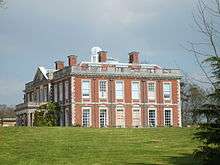Stansted Park
Stansted Park (including Stansted House) is an Edwardian country house in the parish of Stoughton, West Sussex, England. It is near the city of Chichester, and also the village of Rowlands Castle to the west over the border in Hampshire.


The house is set in the 1,800-acre (7.3 km2) park, with woodland and open land grazed by deer. Stansted House has Carolean revival decor and is listed Grade II*.[1]
History
The house began as a hunting lodge in the 11th century. It was built on the present site in 1688 for Richard Lumley, probably to a design by William Talman. The original house was burnt down in 1900, and rebuilt on the exact footprint of the previous building in 1903. The architect was Arthur Conran Blomfield.
It was purchased by Vere Ponsonby, 9th Earl of Bessborough, in 1924. Since 1983 the House and Estate have been owned by Stansted Park Foundation, a charitable trust charged with the preservation of the estate for the benefit of the nation. The trust was set up by Frederick Ponsonby, 10th Earl of Bessborough, who died without a male heir in 1993. The history of Stansted Park since the 12th century is told in Lord Bessborough's book The Enchanted Forest. Stansted is open to the public from Easter to September. The park is crossed from west to east by the Monarch's Way long distance footpath.
Church
.jpg)
The Chapel of St Paul was built by Lewis Way in 1812-16, as part of his mission to convert the Jews.[2] The Regency building incorporates earlier structures, and is by an unknown architect. It is Grade I listed.[3] It was an inspiration to the poet John Keats when he was writing The Eve of St. Agnes.[4] The church was restored by Harry Stuart Goodhart-Rendel in 1926 and again after bomb damage in 1947. The chapel is no longer open for public worship and is in the care of the Stansted foundation.
Light Railway

The Stansted Park Light Railway (50.88442°N 0.92255°W) is a 7 1⁄4 in (184 mm) gauge miniature railway on the grounds of Stansted House. The railway opened on Easter 2005, and is designed to attract more visitors to the House, which is located in a forest near Havant.
The railway uses locomotives and carriages designed and built by railway volunteers. The railway is rapidly expanding. The new extension is now complete, and incorporates a 12-foot span girder bridge. A new locomotive shed is also nearly finished.
Early cricket
In June 1741 a cricket between Slindon Cricket Club and Portsmouth Cricket Club was played in the park.[5] It is the earliest report of a match involving the Slindon team. The team's patron Charles Lennox, 2nd Duke of Richmond, wrote in a letter to his friend Thomas Pelham-Holles, 1st Duke of Newcastle, that "above 5,000 people" were present.[5][6] This is the only time that Stansted Park is mentioned in surviving cricket records. The cricket club still plays fixtures during the summer months.
References
- Historic England. "Details from listed building database (1000327)". National Heritage List for England. Retrieved 29 September 2015.
- Price, Stanley & Munro (2012). The Road to Apocalypse. London: Notting Hill Editions.
- Church of St Paul, Stoughton, British Listed Buildings
- "St Paul, Stansted". A church near you. 2010. Retrieved 19 October 2013.
- McCann, p. 18.
- Maun, p. 104.
Bibliography
- ACS (1981). A Guide to Important Cricket Matches Played in the British Isles 1709 – 1863. Nottingham: ACS.
- McCann, Tim (2004). Sussex Cricket in the Eighteenth Century. Sussex Record Society.
- Maun, Ian (2009). From Commons to Lord's, Volume One: 1700 to 1750. Roger Heavens. ISBN 978-1-900592-52-9.
- Lewis Way - A Biography by Geoffrey Henderson, 2015
External links
| Wikimedia Commons has media related to Stansted Park. |
